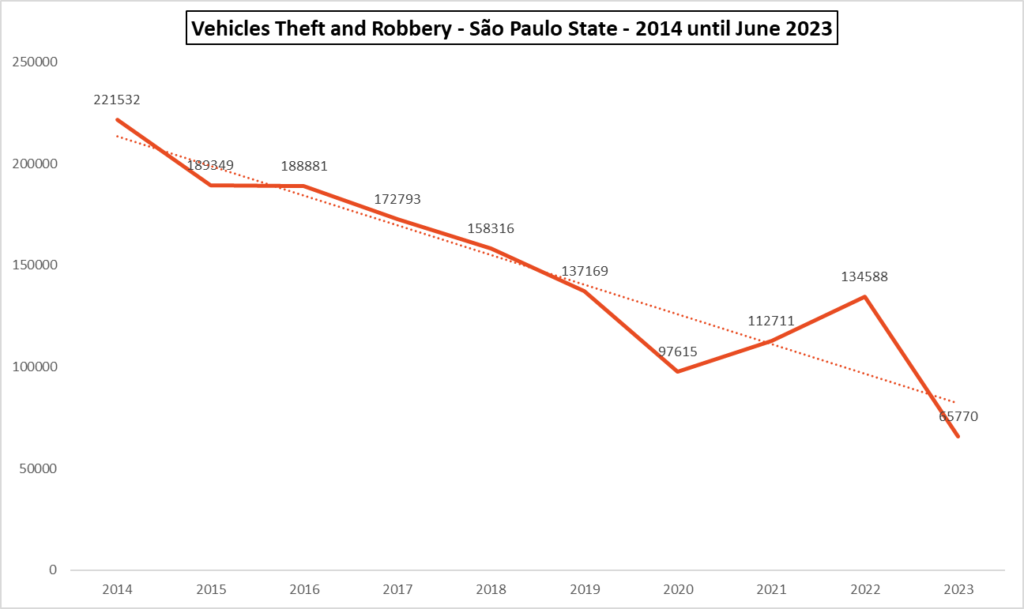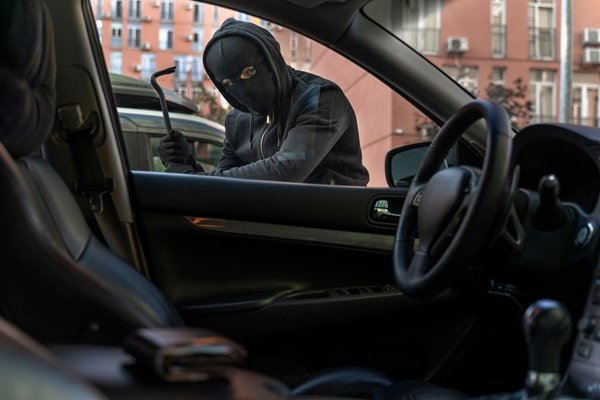Summary
From 2021 to 2022, the number of vehicle robberies and thefts increased across the country, according to data provided by the 2023 Brazilian Public Security Yearbook. It was the result of a reversion of trend, which left many states with high rates of this crime. Despite the overall bad results, the scenario is not completely negative. Authorities from São Paulo have had successes in fighting this type of crime. This success case, according to researchers, may serve as reference to effective policies to be employed – maybe even on how to deal with other illegal markets. At the same time, new technologies arriving at the automotive industry can create new challenges for the protection of assets.
Reversion of Trend
During the Covid-19 pandemic, restrictions to the circulation of assets, people and vehicles provoked a steep reduction in the number of several crimes, like robberies. However, with the lifting of the isolation measures, the reduction trend seen in some crimes reversed. This was the case for vehicle robberies and thefts.
In 2022, 373,225 vehicle robberies and thefts were reported in the country, an average of 1,000 per day. When the social isolation measures were in place, they had a sharp reduction, but grew by 8% in the last year.
Most incidents are thefts (60.3%), thus, actions with no violence involved, which represents a good factor. On the other hand, the fact stresses the need to hire insurance and properly protect vehicles when parked, including the belongings they carry, as they are generally not recovered to the contrary of the robbed ones (i.e., with violence).
The Most Stolen Vehicles
A survey by the National Confederation of Insurance Companies (CNseg) showed the ranking of the 10 most stolen cars in Brazil between January and July 2023.
The best-selling cars are among the most stolen. First, because it is more likely for them to be targeted. Second, because there is a higher demand for car parts from these models.
The cheapest vehicles are also quite targeted since they are easy to resell and there are many available.
SUVs have become attractive, due to their resistance and desirability. Many are used in crimes, because of the space they offer and the turbo engine that many have.Pickups big and small are sought after for their capacity for transporting things. Many thieves and robbers resell them to criminals that carry out cargo robberies.
| 1. Volkswagen Gol | 6. Fiat Siena |
| 2. Ford Ka | 7. Chevrolet Corsa |
| 3. Fiat Uno | 8. Fiat Strada |
| 4. Hyundai HB20 | 9. Fiat Palio |
| 5. Chevrolet Onix | 10. Toyota Hilux |
The Highest Rates
Some states present higher rates of vehicle robbery and theft. The leading state in this ranking is Rio de Janeiro, with 562 cases per 100,000 vehicles in 2022. Pernambuco, in the Northeast region, comes in second, with 534 cases per 100,000 vehicles. This region is also home of the third and fourth places, Piauí, which concentrates a rate of 492 incidents, and Rio Grande do Norte, with 421. Finally, the fifth position belongs to São Paulo, with a rate of 414 incidents.

São Paulo, a Successful Strategy
Despite consecutive increases recorded in 2021 and 2022, São Paulo has significantly reduced the numbers of vehicle robberies and thefts for almost a decade.
This Content Is Only For Subscribers
To unlock this content, subscribe to INTERLIRA Reports.
The peak was seen in 2014, when 221.532 robberies and thefts were recorded, which represented a rate of 502 per 100,000 vehicles. Since then, the new policies implemented by the state administration, associated with other aspects, managed to reduce cases significantly, reaching the lowest total in 2020, when under the pandemic restrictions, the total was 97,615, with a rate of 317.


According to the study “Dismantling Law, PCC and Markets”, released in April on Tempo Social – a magazine published by the University of São Paulo (FFLCH-USP) – there is a “hybrid governance” of the vehicle market, shared between the State, the crime (the First Capital Command – PCC) and market agents. Thus, transformations in these three spheres explain the behavior of robbery and theft statistics in the State.
To explain the connection of the PCC with the decrease in vehicles robberies and thefts, researchers mention the year 2014, which would be a milestone in the faction’s operations in the State of São Paulo, when it gained hegemony in transnational cocaine trafficking through the Port of Santos. Furthermore, it is the starting of the expansion of the criminal group activities to other states. For that to occur, a series of members of the faction, dedicated to ‘classic crimes’, such as vehicle theft and major robberies, began to join international cocaine trafficking networks and to smuggle products (weapons, fake and irregular products).
The market agents highlighted by the work are the Covid-19 pandemic and the ensuing economic crisis, which had a great impact on the consumer market from 2014 to 2021. At the same moment, there was also a shortage of semiconductors, which restricted car production. Furthermore, the sales of auto parts from China, which are cheaper than the originals, has reportedly increased.

However, according to the researchers, the main factor behind this decrease was the implementation of the Dismantling Law (State Law 15,276/2014), which regulated the business of dismantling vehicles for the parts. This activity began to be monitored and must follow rules (license to operate, no debts and no criminal records, control over the origin and the stock) and since then all parts are required to have QR codes. Researchers argue that when a market is legalized and regulated, it becomes harder to sell stolen merchandise and the demand for doubtful origin materials reduces. Even though there are still parts suppliers operating illegally in São Paulo, researchers estimate that they are now a minority. A scenario much better than the previous one, when almost all the parts suppliers operated selling stolen items.
São Paulo Today
With the removal of the pandemic restrictions, the numbers of vehicles stolen started to increase. Even though the other factors mentioned in the section above kept acting to reduce cases in SP, criminals began to have more opportunities with more people circulating, thus a rise in incidents was an expected movement. Vehicles subtracted increased by 15.4% from 2020, to 2021, and by 18.5%, in 2022.
In the first six months of 2023, the state with the largest vehicle fleet in the country had 65,770 car robberies and thefts, a 3% increase when compared to the same period of 2022. Nonetheless, it is still lower than the pre-pandemic level – in 2019, there were almost 68,992 cases – and far from the results recorded in 2014 – when the Dismantling Law was approved –, when 116,200 vehicles were subtracted in the first six months.
When comparing the number of thefts and the number of robberies: in the first semester of 2023, 18,574 car robberies were recorded, a drop of 1.3% compared to the same period of last year (18,574). Meanwhile, the number of thefts increased by 4.2%, from 45,296 to 47,196 registered cases.
The results indicate that São Paulo is now following the national trend, with more thefts and less robberies.
The registered cases are concentrated in the Capital, which had around 27,000 stolen vehicles, and the Metropolitan region (without the capital), with 19,000. Thus, the Metropolitan area concentrated almost 70% of the incidents, even though it has 20 million people, less than half of the state’s population.
In São Paulo city, the most affected Zone is the East (10,984), then the South (8,224), the North (4,192), the West (2,899) and the Central (1,446). When it comes to neighborhoods, the five most targeted cities are: Tatuapé (841), Ipiranga (697), Vila Clementino (624), Perdizes (600), and São Mateus (571).
The presence of many areas for dismantling cars in the East Zone make it a preferential target. The neighborhoods and cities from the Metropolitan area next to it also suffer because of this proximity. As criminals can dismantle a car within 30 minutes, they give preference to vehicles that circulate near the areas where they can remove the parts.
New Opportunities for Attacks Now and in the Future: Key Signal, Media Center and IoV
Digital technologies and electronic parts have become essential components of the automotive industry. The level of dependency on digital could be witnessed with the microchips’ shortage crisis after the pandemic; and the sudden return of the demand for chips led to difficulties for cars manufacturers.
On the other hand, experts have already warned that such techs represent potential breaches for criminals to exploit. For instance, many thieves are now using signal relays to reproduce the signal sent by a car key, so they can steal a car without breaking-in.
Another security concern among modern vehicles is the onboard computer system, also called the infotainment system. Attackers can send malicious programs to the vehicle’s computer system, with the potential to harm its operation, and even manipulate it to cause accidents.

Another technology gradually being brought into reality is the Internet of Vehicles or IoV, a network of cars and other vehicles that can exchange data over the internet. The objective is to improve transport by making it more autonomous, safe and efficient.
IoV can position the car on the highway, while constantly scans the exterior identifying other vehicles, obstacles, streets, weather, and monitoring other factors, which could enable driverless driving.
Nevertheless, since cars remain connected to a network, they become even more vulnerable. These systems could lead thieves to evolve into hackers, constantly looking for vulnerabilities.
Even though this reality may seem a bit futuristic, in fact, it is already happening, but with other kinds of assets, the cell phones. In Brazil’s urban centers thieves and robbers now make partnerships with hackers and technicians capable of quickly unlocking the most advanced cell phones not only to be able to resell it, but also to steal data from them and to access bank accounts and withdraw their victim’s money.
Expectations
Stolen vehicles can be resold, used in other crimes, or dismantled for the parts. This multipurpose helps to explain their great attractiveness and the country’s high rate of 324 vehicles subtracted for every 100,000 vehicles in 2022. On the other hand, the results brought by São Paulo’s public policy, which regulated the market for used parts, give hope of improvements in the long run.
Society must remain aware of new factors that can change the dynamics of the car market, leading to new increases in cases, such as a new technology. In addition, the possibilities offered by the digital features in vehicles are an important selling point for automakers, and something customers are already used to, and they are here to stay.
Therefore, the industry will have to start presenting solutions for improved cybersecurity features, while consumers must seek extra protection provided by assurances.
Nevertheless, traditional security measures like independent GPS tracker and caution when driving and parking remain essential. Furthermore, legislators and law enforcement will also have to think ahead of the criminals and prepare measures to expand rules that worked, like the one that repressed the sales of stolen parts in São Paulo. They must also cooperate with e-commerce companies to prevent the migration of the auto parts black market to online stores.




